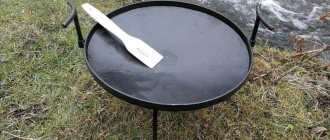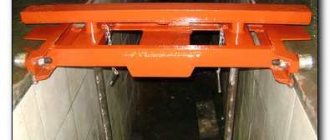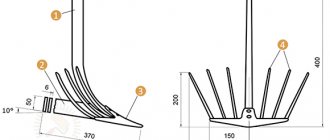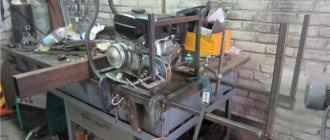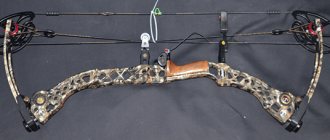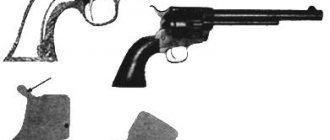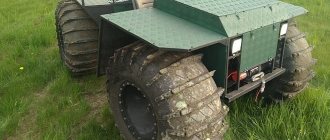Grain crusher: drawings, diagrams, dimensions, photos and videos of a homemade grain crusher. A grain crusher is an indispensable thing in the household; it is used for grinding grains of cereal crops - corn, wheat, barley, oats, for preparing dirt or feed for poultry and animals.
Households usually do not require a powerful mill; a small grain crusher is quite sufficient, which we will manufacture in this article.
There are quite a few types of grain crushers; we will look at the simplest version of a homemade grain crusher that you can make with your own hands.
To make a crusher you will need:
- Electric motor with a power of about 1 kW.
- Sheet metal 3 mm thick.
- Hardened steel for a knife.
- Bolts, nuts, washers, screws - M8.
- A metal barrel or container of suitable size.
Tool:
- Grinder with cutting wheel.
- Electric drill.
- Grinding machine.
- Welding machine.
- Locksmith's tool.
Design Features
A grain crusher is like a coffee grinder enlarged 10-20 times.
But the difference between one and the other machine lies in some parameters.
- Unlike a coffee grinder, a grain crusher grinds grain not into a fine, powder-like powder, but into a coarse-grained substance.
- The grain crusher is capable of grinding tens of kilograms of grain in one grinding session.
- The more grain you need to grind, the longer the device works. For example, to satisfy the monthly demands of a chicken coop in which, say, 20 chickens lay eggs every day, more than one hundred kilograms of grain will be required. To grind 10 buckets of the same wheat or oats, it will take at least one and a half hours of operation of the unit.
The design of the grain crusher includes a number of components.
- Protective housing – made of metals, plastic and/or composite.
- A support that is permanently installed in a specific location or removable (portable).
- Bracket adjustable with nut and bolt.
- The second base has a softener in the form of a rubber “shoe”.
- A pair of engines and the same number of sets of pulleys with a diameter of 6 cm. They are equipped with mortise bolts and keys.
- Seals that soften vibration from motor shafts.
- Knives that chop grain and grass. Both chopped ingredients are the basis of compound feed.
- A funnel with a lid into which unground grain is poured. The second funnel allows the crushed raw materials to be poured into a previously prepared container.
- Frog type lock.
- Removable gratings that allow fractions of different sizes to pass through.
- Rubberized wheel.
Each of the above components can be easily and simply installed on an old washing machine.
A grain crusher made from an activator washing machine (or automatic machine) is a device that has the highest performance and capacity compared to similar ones made from other electrical appliances.
Components selected and/or made by hand must be compatible with the overall dimensions of the final device.
No one will install knives that are several times smaller in diameter into the tank for an activator washing machine - the operation of such a device would become extremely ineffective. A volume of grain that would normally be ground in 20 minutes would take an hour or an hour and a half with reduced knives. In other words, the homemade device is physically balanced.
Similar to the device of a coffee grinder, in a grain crusher the knives, combined with the shafts of electric motors, immediately start when the device is connected to the household lighting network. They finely chop small branches, seeds and grass. The crushed raw materials fall on a sieve, which removes husks and small debris. What has been filtered passes into the container through a funnel, collecting in it.
Drawings of a grain crusher frame.
The grain crusher is mounted on a frame, the figure shows drawings of the frame; a metal corner 50 x 50 mm is used to make the frame.
- Stand (corner 50x50 mm, 4 pcs.).
- Tsarga (2 pcs.).
- Strapping.
- Drive shaft area.
- Crossbar.
- Area.
- Platform for an electric motor.
- Lower cross member (2 pcs.).
I recommend watching a video that shows the structure of a hammer-type grain crusher and its operation.
Popular homemade products on our website
- Gazebo project: drawings, dimensions, diagrams
- How to make an Abyssinian well: diagrams, drawings
- Restoring the Ant scooter, installing…
- How to correctly connect an electric motor from 380 V to...
- Homemade electric bicycle from an angle grinder: assembly photo
- Fracture 4x4 all-terrain vehicle: photos of step-by-step assembly
- DIY electric bike: assembly description
- Homemade ATV: (44 photos) assembly with description
- Homemade swamp vehicle on caterpillars: detailed...
- DIY buggy: photos of step-by-step assembly
- Homemade VAZ 2102 pickup: assembly photo with description
- Homemade buggy “Piranha” 35 photos + assembly description
- DIY ATV: 40 assembly photos
- Moped from a chainsaw: assembly photo, test video
- Do-it-yourself buggy from a chainsaw: assembly photo
What can it be made from?
Let's look at how to make different components for a grain crusher at home.
- The grinding tank is made of thin (0.5-0.8 mm) stainless steel. A metal frame with a valve is fixed next to the base. The outer part of the body is made of a seamless metal pipe with a diameter of 27 cm. The wall thickness of this pipe can reach 6 mm. Inside the same pipe there is a stator, for the manufacture of which a pipe of a slightly smaller diameter was used - for example, 258 mm. In both sections of the pipe, holes are drilled to secure the loading hopper, remove crushed grain, install a grid with the required mesh size, and hangers to secure the shipping hopper. Both pipes are mounted in such a way that they are held in the grooves of the auxiliary flanges located on the side. The latter are connected to each other using several pins. One of the flanges has an internal thread for studs. The second one is drilled in several places. Both flanges also have holes drilled through them to secure the journal bearing housings and are secured to the metal frame using bolts and nuts.
- The rotor is assembled on the basis of prefabricated metal pushers and is equipped with washers. If necessary, these pushers are reversed. After assembly, the rotor is checked for imbalance. If beats are still detected, the rotor is balanced immediately - parasitic vibration can shorten the service life of the entire device.
- The drive shaft contains feather keys and ball bearing sets. Protective washers for ball bearings are based on the requirements of GOST 4657-82 (size 30x62x16).
- The supporting frame with the table is manufactured in a welded version. The starting material is steel angle 35*35*5 mm. The valves are made of thin sheet steel.
- Having prepared the necessary materials and workpieces, we begin to assemble the grain crushing device.
Drawings of a grain crusher drum.
- – flange (coulter disk).
- – disc hub with bearing.
- - toothed drum.
- – base flange.
- – drum flange.
- – electric motor.
- – sieve plate.
- – supporting arc.
- – corner 45 x 45 mm.
- – hole for ground grain.
- – M8 bolt, nut (2 pcs.).
- – electric motor shafts.
On a lathe you need to modify the brake drum, bore the drum from the inside, make the internal diameter - 285 mm, drum depth - 65 mm. You also need to cut a side hole in the drum for the sieve.
Flange modification – the flange is ground down to a diameter of 282 mm.
Schemes and drawings
The grain crusher from the washing machine contains the following components:
- grain bin;
- frame;
- rotor;
- shaft;
- unloading hopper;
- pulley (the requirements of paragraph 40 of GOST 20889-88 are met);
- V-belt;
- electric motor;
- frame with table;
- loading and unloading valves (valves).
Drawings of analogues made on the basis of a motor from a vacuum cleaner, electric drive of an angle grinder, drive and mechanism of a meat grinder differ little from the device made on the basis of a (semi-) automatic washing machine. The principle of operation of the device is no different - which cannot be said about the type of chopping mechanics used.
Master class on making a grain crusher from a washing machine
If you have purchased a new automatic washing machine, do not rush to throw away the old type of device. It will definitely make a high-quality and productive grain crusher. You just need to develop a detailed drawing and purchase some elements.
What you need for work: prepare the essentials
The list of materials and tools will depend on the chosen scheme. Most often, only the motor from the washing machine is used. However, if desired, you can also use a tank.
You will also need:
- rolled metal: plates, pipe sections;
- fasteners;
- sealant.
Device diagram
In terms of its design and operating principle, a grain crusher is similar to a coffee grinder. During the manufacturing process, the main attention should be paid to the knives and the hopper for receiving the finished product.
Preparation of prefabricated elements
- We begin work by preparing the grain bin. We increase the diameter of the drain hole to 12 - 15 cm to ensure sufficient performance of the device. From pipe sections we make pipes of the required size and configuration for discharging crushed grain.
- We cut three knives from durable steel. These should be plates 20 cm long and 1.5 - 2 mm thick. To make the device last longer, you can use a hand saw to make these elements. We drill a mounting hole in the middle of the prepared plates. We sharpen the parallel sides.
- We make a filtration grid that will not allow whole grains to leave the container. Its diameter should be slightly larger than the diameter of the manufactured pipe. The holes in the filtration grid must ensure the unhindered passage of crushed grain.
Attention! The diameter of the filter grid holes should be 3 – 4 mm.
We are preparing a container for crushed grain, or we are thinking about a way to secure the bag to the outlet pipe. To prevent the formation of excessive dust during operation of the device, the receiving hopper must be sealed against the outlet pipe.
Assembly of the structure
We assemble as follows:
- We install a discharge pipe into the expanded opening of the tank, ensuring sufficient tightness of the connection.
- We install the knives on the motor shaft. To avoid overlapping of the blades during operation, be sure to tighten the clamping nut after each plate.
- We attach a filtration grid in front of the outlet pipe. It should be located at an angle of 15 - 200 to the horizontal. Considering that the bottom of the washing machine tank is inclined to ensure complete drainage of water, there should be a right angle between the base and the installed plate. To fasten the plate we use bolts.
- We coat the joint with sealant to eliminate the presence of gaps and cracks through which whole grain could mix with crushed grain;
- Let's start the device. Let's check its functionality.
- If you don’t have a solid washing machine, but you still have a working engine, you can also use it to make a grain crusher with your own hands.
Structure of a grain crusher
Grain crushers are mainly used for farms, but ordinary summer residents and people who regularly live in villages often resort to using grain crushers. Some of them, wanting to save money on its purchase, managed to use an ordinary washing machine for this purpose with minor modifications.
A grain crusher is a technical unit with which you can make feed for feeding livestock at home. It is made by crushing and grinding various grains to a fine consistency.
Video: Homemade feed crusher
For more details about the grain crusher with your own hands, watch the video:
It is known that the processed and crushed product is much better absorbed in the animal’s body, which has a positive effect on its reproductive functions and productivity, which is expressed in milk production and egg laying.
Thus, we can say that the grain crusher is an indispensable assistant for any farmer who maintains large or medium-sized livestock and poultry.
Frequent purchases of ready-made feed can significantly hit the budget, but making feed yourself will allow you to save quite a lot of money.
This link will tell you how to make a cultivator with your own hands.
The operating principle of all grain crushers is similar to the operation of a conventional household coffee grinder, only on a more global scale. The unit is first plugged into a regular power supply, after which the engine is started. This is very important, because the engine must first warm up before you can start working.
Next, raw materials for processing are poured into a special tank (hopper), after which it enters the crushing chamber, where the grinding process itself takes place. Grinding occurs using special knives located in this chamber.
Then, the raw materials are sifted through a sieve of a certain diameter (usually there are several of them in a set). It is the diameter of this sieve that will determine the fraction, i.e. degree of grinding of grain or other crops.
By the way, depending on the characteristics of a particular grain crusher, it can process a wide variety of raw materials:
- rye;
- barley;
- legumes;
- corn;
- cake;
- husk, etc.
Some units are equipped with a special disc grater that allows you to grind various root vegetables, fruits and herbs.
In general, the design of a grain crusher is quite simple, so it is quite possible to make it at home.
There are quite a few detailed methods with drawings describing this process on the Internet. The method of converting from a washing machine deserves special attention , because its device is already somewhat reminiscent of the notorious coffee grinder.
You will find all the information about the AID-2 milking machine in this article.
Making your own grain crusher from a vacuum cleaner
If you don't have a washing machine, look for a vacuum cleaner. It can be used in whole or in part. It all depends on which design seems more attractive to you and what skills you have. We invite you to get acquainted with a possible implementation option.
We prepare everything necessary for work
To make a grain crusher from an old vacuum cleaner, you should prepare:
- metalworking and metal-cutting tools;
- sandpaper;
- drill;
- fastening elements;
- pipe sections about 15 cm long for making an outlet pipe;
- ready-made knives or metal plates for their manufacture;
- a lattice with small cells, which is necessary for the manufacture of a sieve intended for sifting grain. If this is not available, you can use a metal sheet in which holes of the required diameter are drilled.
Attention! The above list is approximate.
Device diagram
The design of the device depends on which part is used. Most often, preference is given to options that involve the use of one engine. It is installed on the base, under which there is a container for receiving crushed grain.
Preparation of prefabricated elements
At the preparatory stage:
- we make the base using plywood, laminate or rolled metal;
- disassemble the vacuum cleaner to remove the engine;
- drill a hole in the base. Its diameter must correspond to the diameter of the motor shaft;
- If there are no ready-made knives, we make them from metal plates. With a thickness of about 1.5 mm, their length should not exceed 20 cm;
- If there is no ready-made sieve, we make it from a metal sheet.
Assembly of the structure
The process of assembling a grain crusher from a vacuum cleaner includes a number of stages, each of which deserves special attention:
- Using a nut, fix the knife on the motor shaft;
- install a sieve;
- We place a container under the sieve into which the crushed grain will flow.
Attention! Installing a tin box for loading grain will simplify the crushing process.
What equipment is needed for grain storage
The provision of granaries with technological and engineering equipment depends on the functional purpose of the building. Mechanized conveyors are installed in rooms with sloping floors.
List of equipment that allows you to control the microclimate:
- fans providing condensate removal and air supply,
- temperature and humidity sensors,
- floor ventilation ducts for active ventilation during grain storage,
- control center system unit,
- ventilation units for supply and exhaust ventilation.
From the Bulgarian
A characteristic property of a manual electric grinder is the axis located perpendicular to the cutting disc. To make a grain crusher from an angle grinder (grinder), do the following.
- Mark and cut a rectangular piece from thick (1 cm or more) plywood.
- Cut a round hole in the cut piece of plywood - in the shape of the main structure in which the cutting disc rotated.
- Secure the plywood with the bolts and metal bracket included in the kit. The axis of rotation should be directed downwards.
- Make a cutter from a steel strip of suitable length, width and thickness. As in the previous case, the knives must be carefully sharpened and centered. Insufficient centering can eventually break the angle grinder gearbox.
- Not far from the angle grinder mounted in the tank for crushing grain, make a hole and provide it with a funnel. Through it, uncrushed raw materials are poured into the grain crusher. The funnel with a hole is placed not under the grinder drive, but above it.
- Below the drive, mount a sieve made from a used pan. It is drilled using a small drill (about 0.7-1 mm).
Assemble the grain crusher. Place it on a pallet or box. Under the lower funnel, where the crushed raw materials are poured, place, for example, a bucket. The funnel can be made from the cut off top of a plastic food bottle - the diameter of the neck is enough for the poured grain to easily and quickly pass into the grain crusher.
Product types
The first grain grinders or grain crushers were millstones on which grain was ground manually or with the help of horse traction. Over time, this design was improved and today you can find different types of grain crushers.
Centrifugal
Centrifugal or impact crusher is based on the impact crushing method. The design resembles a centrifuge. The grain enters a rotating plane, is accelerated by centrifugal force and is thrown into a crushing chamber with a special hard lining. The high kinetic energy of particles ensures their destruction upon impact with a stationary wall surface. The pressure in the chamber is created by a fan.
Screw
The screw type grain crusher has crushing screws that ensure grinding. The body is welded, with a groove-lattice bottom. Similar designs are used for crushing coal. They have a large margin of safety and are suitable for processing hard grain crops.
Melnichnaya
Mill or jaw crushers are historically the first type of crusher. The principle of operation is simple: the grain is compressed by two solid plates (cheeks), one of which is fixedly fixed, and the second is installed on a swinging base. Performing reciprocating movements, the swinging and stationary jaws compress and thereby crush the raw materials entering the machine.
The advantages of such crushers:
- simplicity of design and, therefore, manufacturing and repair;
- the ability to adjust the throughput channel to select the required grain size obtained at the output.
The disadvantages include:
- rapid wear of such mechanisms due to abrasion of the pressing elements (cheeks);
- uneven shape of processed grains.
Rolling
Another option that has stood the test of time is the roller mill, which can be supplied as an automatic or manual model. The main mechanism of the design is a movable shaft. Its function is to redirect the flow of grain into a small gap between itself and the stationary part of the structure. This ensures high-quality and fast grain grinding.
You can make a cereal yourself
Depending on the design, the grain crusher can be:
- two-roller - has lower productivity and a very simple design;
- three-roller - equipped with an additional shaft and allows for better grinding of raw materials.
This type of crushers is characterized by high quality processing and an affordable price. They quickly pay for themselves due to increased productivity and quality of the finished product.
From a meat grinder
To make sure that the meat grinder will grind the grain, you can use resins, for example, hazelnuts or walnuts in shelled form. There is no need to make a knife that performs the functions of a cutter “from scratch” - it is already included in the kit. For the small fraction of grain, you must use the smallest standard sieve, also included in the delivery set.
In order for the grain to be milled continuously, it is necessary to install a large funnel above the grinding mechanics, for example, from a 19-liter bottle with the bottom cut off.
A hole is made in the lid of a diameter at which the poured grain will not pass through the neck faster than it is passed in crushed form through the crusher of the meat grinder. In principle, the meat grinder does not need to be modified in any way. The grain should not be too hard - not all meat grinders can handle durum wheat equally effectively. If you cannot use a meat grinder as a grain crusher, use a coffee grinder.
How to make a crusher mill with your own hands
Making a grain crusher with your own hands is not that difficult. To do this, you need to have on hand a motor from an old household appliance, for example, a vacuum cleaner or washing machine.
In addition, you must have some locksmith skills. By the way, when assembling such equipment with your own hands, you need to remember the safety rules. Since all engines operate on electricity, it is necessary to take all measures to reduce the traumatic risk of the assembled product.
We must not forget that fast-rotating parts are used as a working body, which can cause injury to the person working on it.
Structure of a grain crusher, design features of the machine
Manufacturers put a variety of crushers on the market, with different characteristics, productivity, etc. Most of this equipment is easy to maintain and does not take up much space. As noted above, in practice crushers are used that use rotary or hammer principles in their operation.
Rotary machines have a drum with knives. In hammer mills, hammers are used as a working tool, which are loaded inside the drum.
By the way, there is equipment that uses compressed air as an energy source. The processed raw material moves inside the drum along with air. As a result of this, the quality of the resulting product increases dramatically. In addition, in this, and in many other designs, magnets are used that select metal particles that get into the mixture.
Crushers for home use
Crushers that are used in households can also be divided into several groups based on drive type . Based on this feature, you can distinguish such machines as:
- A manual crusher is the simplest device, which requires more time and effort to work with. Such a unit grinds material into coarser products, which in the near future will be used to feed older cattle.
- A pneumatic crusher is a machine that is used to process corn as well as other small products. Such a unit operates quite quickly and grinds grain into small fractions, which should be mixed into food for small pets, as well as for quails and other varieties of smaller poultry.
- Electric type crusher - this device has the highest level of productivity and simple design. It does not include large dimensions, and in most cases it is purchased both for households and farmland.
How to choose a grain crusher: expert advice
Choosing the right model
How should you choose a crusher that will meet all consumer requirements? To do this, you need to know the answers to some questions:
- Performance. A high grinding speed ensures high productivity in obtaining finished products, and accordingly, the use of such an installation will be highly efficient. Such installations can be considered the optimal solution for large farms. For home work, an installation with a low or medium processing speed of raw materials is sufficient.
- Price. The equipment must not only ensure high quality of the resulting product, but also generate certain income to recoup the investments made in this equipment.
- Grinding degree. The device must be selected based on the type of livestock and poultry the produced feed will be intended for.
- Drive station power. The greater the power of the installed power plant, the greater the productivity of the installation. It must be taken into account that the higher the engine power, the higher the energy costs.
- The company is a manufacturer. Undoubtedly, there are world-famous companies that produce shredders, but you need to think three times about how quickly the funds invested in brands will pay off.
When choosing a model, you must be guided by the characteristics specified by the manufacturer.
Crusher balancing process
Most equipment that uses rotating components as a working tool undergoes a balancing procedure. This work can be done either independently or with the help of invited specialists.
When balancing, the following sets of work must be performed:
- identifying the causes of vibrations and eliminating them;
- monitoring the condition of equipment in terms of vibration;
- balancing shafts in existing bearings;
Why is balancing necessary? The answer lies on the surface. The thing is that the presence of excessive vibration leads to failure of the bearing units, and as a result, everything can end very sadly.
Description
What is a kruporushka
The device is used for quick preparation of feed from crushed grain. Otherwise they are called grain crushers. On an industrial scale, grain crushers are used in poultry farms and food processing plants.
The following products are most often processed using this method:
- wheat;
- peas;
- millet;
- barley;
- oats;
- buckwheat;
- rice;
- corn;
- peas;
- soybeans
The main difference between a grain grinder and a mill: the grains are not ground into flour, but are simply crushed into several relatively large parts.
Where and how to use
Using the grinder is very simple. At the top there is a bunker where raw materials are loaded. Grinding is carried out in a drum, which is driven by an electric motor. In the drum, the grain is also mixed with other additives - grass, dried vegetables, straw.
Most often, on private farms, grains are used to prepare feed for birds, pigs and cattle. Many types of cereals are processed in agricultural production in a similar way.
Principle of operation
The grains are sent to the receiving hopper, after which they arrive in portions, having gone through the calibration stage. After the preliminary stage of dehusking, the grain enters a drum, in which it is divided into four unequal parts. The different sizes of particles determine the cyclical nature of the work: first, larger pieces are crushed, then small ones go to even smaller ones, until the finished product acquires the same size and beautiful appearance.
The incoming product can be automatically sorted by simply placing a sieve at the outlet. As a result, smaller fractions will be used as poultry feed, while larger fractions will be used for cattle. The productivity of the grinder depends on the hardness and other characteristics of the raw material and ranges from 150 to 300 kilograms per hour. You can additionally equip the device with a grinding device, and then you can eat high-quality grain yourself.
Grain crusher performance
The process of functioning of a rotary chopper involves the movement of the cutting knife. It is needed to crush the masses that should be fed inside the receiving hopper.
The hammer preparation can grind grain efficiently using hammers that are attached to a strong base.
- Products obtained using a hammer machine will be considered the most effective. This can be achieved with the help of a high amplitude of movement of the hammers, which are capable of crushing even individual grains of grain.
- At the same time, the impact crusher can consume much less electricity and has a high productivity factor.
- If the farm has a large number of adult livestock and poultry species, it would be best to buy an impact crusher. But in the case when a farmer breeds smaller poultry and a large number of young livestock for trade, then the optimal choice in this case will be in favor of hammer grinding of grain.
- It is imperative to test a device that you have produced yourself. It is worth remembering that the grinder engine requires regular lubrication, otherwise it will quickly break due to abrasion of the main elements in the device.
Homemade grain crusher: diagram.
The grain crusher consists of the following units:
- Gate valve for regulating the flow of grain into the working chamber.
- Grain bunker.
- Electric motor on/off button.
- Electric motor.
- Sleeve.
- Axis.
- Washer.
- Screw.
- Screw.
- Base.
- Working chamber housing.
- Container for crushed grain.
- Bolt.
- Screw.
- Metal mesh (sieve).
Diagram of the crusher working chamber.
- Base.
- Working chamber housing.
- Screw.
- Sieve.
Recommendations
To ensure that the shredder's performance is high enough, follow the advice of experts.
- Insulate the motor using an additional casing made from, for example, a large tin can. The fact is that the motor gets into a dusty environment - this dust is formed when grinding dry grain. The engine may become clogged with deposits, and its operation will slow down - a noticeable part of its useful power will be lost.
- Do not use the grain crusher at maximum speed, trying to grind tons of grain in one go. A large farm with large numbers of farm animals will require two or more grain crushers. It is better not to skimp on equipment so that it does not break down after a few days, but works for a number of years.
- Use grain collection containers with as large a capacity as possible.
- Clean and lubricate the mechanics every three months or six months. Regular maintenance - and scheduled replacement - require bearings, without which no electric motor would work.
- The listed measures will allow the user to process large volumes of grain without investing extra in repairs and without stopping urgent work.
